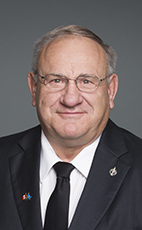Mr. Speaker, I am grateful for the opportunity to participate in this debate on Bill S-7, the zero tolerance for barbaric cultural practices act. This bill proposes to amend the Immigration and Refugee Protection Act, the Civil Marriage Act and the Criminal Code. The amendments proposed in Bill S-7 would provide more protection and support for vulnerable individuals, most especially women and children.
The passage of Bill S-7 would render permanent and temporary residents inadmissible if they practice polygamy in Canada. It would strengthen Canadian marriage laws by establishing a new national minimum age for marriage of 16 years and by codifying the existing legal requirements for free and enlightened consent for marriage and for ending an existing marriage prior to entering another. It would criminalize certain conduct related to underage and forced marriage ceremonies, including the act of removing a child from Canada for the purpose of such marriages. It would help protect potential victims of underage or forced marriages by creating a new specific court-ordered peace bond where there are grounds to fear someone would commit an offence in this area and ensure that the defence of provocation could not be used in so-called honour killings and many spousal homicides.
Undertaking these measures would support the government's throne speech commitment to ensure that barbaric cultural practices do not occur on Canadian soil. Women seeking better lives for themselves and their families in Canada should never be subject to constant fear and threat of violence or death simply for living their lives and pursuing better opportunities for themselves. Practices that include early and forced marriages, polygamy and any so-called honour-based violence run counter to Canadian values and democratic norms. They often contravene basic human rights, especially subjecting women and girls to brutal and inhumane treatment.
The negative impacts these practices have on families and society in general range from influencing immigration outcomes to reducing opportunities for integration and success while also limiting the free choice of vulnerable women and children. We know that there are additional barriers for immigrant and newcomer women and girls who wish to protect themselves and seek help. We want to ensure that help and protection is available if and when they need it.
I would like to speak on one specific measure proposed by Bill S-7. I would like to focus the remainder of my time on the provision that aims to augment tools that currently exist to counter the practice of polygamy.
As we know, polygamy has been illegal in Canada for 125 years. For many years we have recognized in this country that this practice is an affront to Canadian values. Polygamist marriages are not legally valid in Canada and are currently prohibited in the Criminal Code. As well, the Immigration and Refugee Protection Act already specifies that polygamist spouses cannot be sponsored.
When he upheld Canada's criminal law ban on the practice of polygamy, the hon. Chief Justice Bauman of British Columbia's Supreme Court recognized the physical, psychological and social harms associated with the practice of polygamist marriage. For these reasons, it remains against the criminal law in Canada to practice polygamy or to enter into a polygamist union.
While the responsibility for the prosecution of most crimes, including polygamy, rests with the provincial attorneys general, the prohibition in the Criminal Code upheld in 2011 is the responsibility of this Parliament. In turn, this Parliament and the Government of Canada also have jurisdiction over immigration laws and their enforcement. Since polygamy does occur in some countries from which Canada draws immigrants, we need to ensure that our immigration system has the necessary tools to counter it. Bill S-7 would give us these additional tools.
Bill S-7 would create a new ground of inadmissibility in the Immigration and Refugee Protection Act for practising polygamy, increasing our ability to prevent polygamy from occurring on Canadian soil and ensuring that the immigration system is not enabling this practice in any way.
The bill would give immigration officers enhanced tools with which to render both temporary and permanent residents inadmissible for practising polygamy. The new inadmissibility would mean that those in polygamous marriages abroad wanting to enter Canada on a temporary basis would only be able to enter this country alone, without their spouses. Those who cease to practise polygamy would, of course, no longer be inadmissible.
It also means that permanent residents found to be practising polygamy could lose their status and be removed from Canada on that basis alone. Further, we would no longer need a criminal conviction or a finding of misrepresentation in order to begin removal proceedings.
We know that more needs to be done to protect women and girls in our immigration system, despite all of our government's best efforts and intentions. That is why it is so important that the measures in Bill S-7, including the additional measures I have discussed regarding polygamy, are enacted. If passed, they would strengthen our laws to protect Canadians and newcomers to Canada from barbaric cultural practices.
This bill sends a clear message to anyone coming to Canada that such practices are not acceptable and run counter to our principles of freedom, democracy, human rights and the rule of law. The zero tolerance for barbaric cultural practices act stands up for immigrant women and girls who have come to Canada for a better life and better opportunities, ensuring that they have every chance to succeed and make their own choices about the way they want to live their lives.
As legislators, it is our responsibility to prevent those practices that abuse vulnerable women and children, such as polygamy, from happening on our Canadian soil. By ensuring the passage into law of the zero tolerance for barbaric cultural practices act, we will be taking a major step towards the goal by increasing the Government of Canada's ability to prevent polygamy from occurring in this country.
I strongly encourage all members to join me in supporting Bill S-7.

